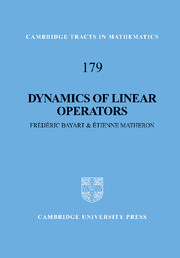Book contents
- Frontmatter
- Contents
- Introduction
- 1 Hypercyclic and supercyclic operators
- 2 Hypercyclicity everywhere
- 3 Connectedness and hypercyclicity
- 4 Weakly mixing operators
- 5 Ergodic theory and linear dynamics
- 6 Beyond hypercyclicity
- 7 Common hypercyclic vectors
- 8 Hypercyclic subspaces
- 9 Supercyclicity and the Angle Criterion
- 10 Linear dynamics and the weak topology
- 11 Universality of the Riemann zeta function
- 12 An introduction to Read-type operators
- Appendices
- References
- Notation
- Author index
- Subject index
Introduction
Published online by Cambridge University Press: 10 December 2009
- Frontmatter
- Contents
- Introduction
- 1 Hypercyclic and supercyclic operators
- 2 Hypercyclicity everywhere
- 3 Connectedness and hypercyclicity
- 4 Weakly mixing operators
- 5 Ergodic theory and linear dynamics
- 6 Beyond hypercyclicity
- 7 Common hypercyclic vectors
- 8 Hypercyclic subspaces
- 9 Supercyclicity and the Angle Criterion
- 10 Linear dynamics and the weak topology
- 11 Universality of the Riemann zeta function
- 12 An introduction to Read-type operators
- Appendices
- References
- Notation
- Author index
- Subject index
Summary
Linear dynamics is a young and rapidly evolving branch of functional analysis, which was probably born in 1982 with the Toronto Ph.D. thesis of C. Kitai [158]. It has become rather popular, thanks to the efforts of many mathematicians. In particular, the seminal paper [123] by G. Godefroy and J. H. Shapiro, the authoritative survey [133] by K.-G. Grosse-Erdmann and the beautiful notes [222] by J. H. Shapiro have had a considerable influence on both its internal development and its diffusion within the mathematical community. After more than two decades of active research, this would seem to be the proper time to write a book about it.
As the name indicates, linear dynamics is mainly concerned with the behaviour of iterates of linear transformations. On finite-dimensional spaces, things are rather well understood since linear transformations are completely described by their Jordan canonical form. However, a new phenomenon appears in an infinite-dimensional setting: linear operators may have dense orbits. In fact, quite a lot of natural operators have this property.
To settle some terminology, let us recall that if T is a continuous linear operator acting on some topological vector space X, the T-orbit of a vector x ∈ X is the set O(x, T) := {x, T(x), T2(x), … }. The operator T is said to be hypercyclic if there exists some vector x ∈ X whose T-orbit is dense in X. Such a vector x is said to be hypercyclic for T.
- Type
- Chapter
- Information
- Dynamics of Linear Operators , pp. viii - xivPublisher: Cambridge University PressPrint publication year: 2009

